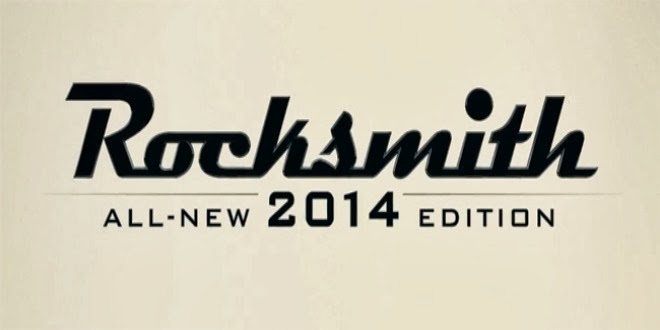Rocksmith 2014 All New Edition - Review
→ October 22, 2013 From the plastic-instrument-littered graveyard of the rhythm game genre rose the original Rocksmith, a game that took the familiar note-highway interface of the Guitar Hero series and applied it to the full scale-length of a proper guitar. Using that same impressive note-recognition technology, Rocksmith 2014 makes for a much smoother learning and practicing experience thanks to its effortless presentation and more flexible approach to player progression. It’s always going to be a long way to the top if you want to rock and roll, but Rocksmith 2014 makes it a heck of a lot easier to sit back and enjoy the ride. The “2014” moniker may suggest a merely incremental upgrade from the original game, but Rocksmith 2014 has benefited from quite a significant overhaul to all facets of the experience. Most readily apparent is the completely revamped and non-linear menu navigation. Everything you need at any moment is right under your increasingly calloused fingertips. You can swiftly hop in and out of technique lessons, chord charts, songs, and the wonderfully retro Guitarcade mini-games; it never really gives you enough of a pause to put down your instrument.
There’s been a variety of tweaks across the board to Rocksmith 2014’s actual gameplay, most notably the new visual cues for things like tapped notes and harmonics, along with a
Rocksmith 2014
October 22, 2013
Rocksmith 2014 Edition is the second installment of the music hamming game, allowing players to plug any real guitar or bass directly into their game system to begin their musical journey.
Some songs will certainly take longer to master than others, but the tracklisting also feels far more considered this time around. While there’s no accounting for taste, the 50 on-disc tracks available feel satisfyingly comprehensive when it comes to technique, spanning a skill range from the simple power-chords of the Ramones’ Blitzkrieg Bop and Jack White’s Sixteen Saltines; to carpal tunnel-inducing metal tracks like Iron Maiden’s The Trooper and Mastodon’s Blood and Thunder; to the technical tour de force that is Joe Satriani’s Satch Boogie. If you own the original game you can import its entire track list too (for a one-time fee), and any DLC also carries across - with all of the back catalogue tracks supporting Rocksmith 2014’s new gameplay features.
Of course it’s not enough just to play like your favourite guitar heroes; you need to sound like them too. The actual guitar tones in Rocksmith 2014 are more authentic than ever thanks to the official emulation of big-name amp makers like Marshall, Orange, and ENGL. You can play through virtual recreations of such lusted-after rigs as Marshall’s JCM800 or the Orange Tiny Terror, and while they’re never going to blow your hair back like the real thing, they provide near enough approximations to serve as a sort of try-before-you-buy service. Considering that Rocksmith 2014 costs less than most small practice amps, the new amp modelling alone might make it appealing to bedroom guitarists tight on space, like perhaps those in college dorm rooms.
Aside from the entirely new list of songs to learn and amp models to customise, there’s a suite of new Guitarcade mini-games that are essentially a fun way to forget how otherwise mundane it can be to practice scales. Not only are there more of them this time around, but they’re also meatier and better presented. For example, the 2D beat-’em-up inspired Scale Warriors - in which you pummel street thugs by hitting corresponding notes in alternating scales - is set across multiple urban environments, each linked with stylish 16-bit inspired cutscenes.
But my favourite addition to Rocksmith 2014 is the innovative Session mode, which is honestly like nothing else I’ve ever experienced in any game or piece of musical software. You pick the instruments in your four-piece backing band, customise settings such as the scale and tempo, and then you can basically go nuts all up and down the neck with the band reacting dynamically to the intensity of your playing. Not only is this a great way to explore the fretboard and experiment with new scales, but it’s also an invaluable tool for honing your improvisational skills - you can even play it with a friend for some guitar solo face-offs (or face-melting-offs). It’s a great vehicle for coming up with riffs of your own too, which makes it a slight shame that there’s no in-game recorder to capture your ideas with.
Yet for all of its features and encyclopedic approach to chords and scales, there is a ceiling to the skills Rocksmith 2014 can provide you with. It stops short of teaching you advanced techniques such as sweep-picking or more extreme two-handed tapping, but it isn’t really aiming to be the be-all and end-all of guitar and bass tutelage. It’s not meant to be played in a vacuum devoid of other instructional influences - you should still absolutely watch videos on YouTube, buy tablature books, jam with friends or even seek out more formal teaching if you really want to master the fretboard.
Lastly, it would be remiss of me not to mention the audio latency levels. The developers claim that they’ve tightened up the latency at least in terms of the software, and certainly when I played the PC version of Rocksmith 2014 or the console versions with the audio fed into a separate home theatre system (via analogue cables), the audio latency was truly imperceptible. However, when I ran the audio via HDMI straight into the back of television, there was still a noticeable delay between when a note was struck and when it sounded out of the TV speakers. So for those of you who have no external devices to output the audio to, be mindful that it may have a negative impact on your enjoyment with the game.
Become a fan of ZZ Gaming Zone.
Like This Then Share...




.jpg)








0 comments: